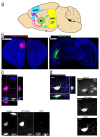Changes in Representation of Thalamic Projection Neurons within Prefrontal-Thalamic-Hippocampal Circuitry in a Rat Model of Third Trimester Binge Drinking
- PMID: 33806485
- PMCID: PMC8001051
- DOI: 10.3390/brainsci11030323
Changes in Representation of Thalamic Projection Neurons within Prefrontal-Thalamic-Hippocampal Circuitry in a Rat Model of Third Trimester Binge Drinking
Abstract
Alcohol exposure (AE) during the third trimester of pregnancy-a period known as the brain growth spurt (BGS)-could result in a diagnosis of a fetal alcohol spectrum disorder (FASD), a hallmark of which is impaired executive functioning (EF). Coordinated activity between prefrontal cortex and hippocampus is necessary for EF and thalamic nucleus reuniens (Re), which is required for prefrontal-hippocampal coordination, is damaged following high-dose AE during the BGS. The current experiment utilized high-dose AE (5.25 g/kg/day) during the BGS (i.e., postnatal days 4-9) of Long-Evans rat pups. AE reduces the number of neurons in Re into adulthood and selectively alters the proportion of Re neurons that simultaneously innervate both medial prefrontal cortex (mPFC) and ventral hippocampus (vHPC). The AE-induced change unique to Re→(mPFC + vHPC) projection neurons (neuron populations that innervate either mPFC or vHPC individually were unchanged) is not mediated by reduction in neuron number. These data are the first to examine mPFC-Re-HPC circuit connectivity in a rodent model of FASD, and suggest that both short-term AE-induced neuron loss and long-term changes in thalamic connectivity may be two distinct (but synergistic) mechanisms by which developmental AE can alter mPFC-Re-vHPC circuitry and impair EF throughout the lifespan.
Keywords: AAV; alcohol; connectivity; development; fetal alcohol spectrum disorders (FASD); immunofluorescence; immunohistochemistry; thalamus; unbiased stereology.
Conflict of interest statement
The authors declare no conflict of interest. The funders had no role in the design of the study; in the collection, analyses, or interpretation of data; in the writing of the manuscript, or in the decision to publish the results.
Figures





Similar articles
-
Representation of prefrontal axonal efferents in the thalamic nucleus reuniens in a rodent model of fetal alcohol exposure during third trimester.Front Behav Neurosci. 2022 Sep 8;16:993601. doi: 10.3389/fnbeh.2022.993601. eCollection 2022. Front Behav Neurosci. 2022. PMID: 36160686 Free PMC article.
-
Single-day Postnatal Alcohol Exposure Induces Apoptotic Cell Death and Causes long-term Neuron Loss in Rodent Thalamic Nucleus Reuniens.Neuroscience. 2020 May 21;435:124-134. doi: 10.1016/j.neuroscience.2020.03.046. Epub 2020 Apr 3. Neuroscience. 2020. PMID: 32251710 Free PMC article.
-
Executive functioning-specific behavioral impairments in a rat model of human third trimester binge drinking implicate prefrontal-thalamo-hippocampal circuitry in Fetal Alcohol Spectrum Disorders.Behav Brain Res. 2021 May 7;405:113208. doi: 10.1016/j.bbr.2021.113208. Epub 2021 Feb 25. Behav Brain Res. 2021. PMID: 33640395 Free PMC article.
-
Role of the thalamic nucleus reuniens in mediating interactions between the hippocampus and medial prefrontal cortex during spatial working memory.Front Syst Neurosci. 2015 Mar 10;9:29. doi: 10.3389/fnsys.2015.00029. eCollection 2015. Front Syst Neurosci. 2015. PMID: 25805977 Free PMC article. Review.
-
The nucleus reuniens orchestrates prefrontal-hippocampal synchrony during spatial working memory.Neurosci Biobehav Rev. 2021 Sep;128:415-420. doi: 10.1016/j.neubiorev.2021.05.033. Epub 2021 Jul 1. Neurosci Biobehav Rev. 2021. PMID: 34217746 Free PMC article. Review.
Cited by
-
Astrocyte Extracellular Matrix Modulates Neuronal Dendritic Development.Glia. 2025 Aug;73(8):1589-1607. doi: 10.1002/glia.70020. Epub 2025 Apr 7. Glia. 2025. PMID: 40192069
-
Astrocyte extracellular matrix modulates neuronal dendritic development.bioRxiv [Preprint]. 2024 Aug 22:2024.08.06.606424. doi: 10.1101/2024.08.06.606424. bioRxiv. 2024. Update in: Glia. 2025 Aug;73(8):1589-1607. doi: 10.1002/glia.70020. PMID: 39211148 Free PMC article. Updated. Preprint.
-
Representation of prefrontal axonal efferents in the thalamic nucleus reuniens in a rodent model of fetal alcohol exposure during third trimester.Front Behav Neurosci. 2022 Sep 8;16:993601. doi: 10.3389/fnbeh.2022.993601. eCollection 2022. Front Behav Neurosci. 2022. PMID: 36160686 Free PMC article.
-
The Neurobiology of Learning and Memory in Rodent Models of Fetal Alcohol Spectrum Disorders.Adv Exp Med Biol. 2025;1473:41-65. doi: 10.1007/978-3-031-81908-7_3. Adv Exp Med Biol. 2025. PMID: 40128474 Review.
References
Grants and funding
LinkOut - more resources
Full Text Sources
Other Literature Sources

